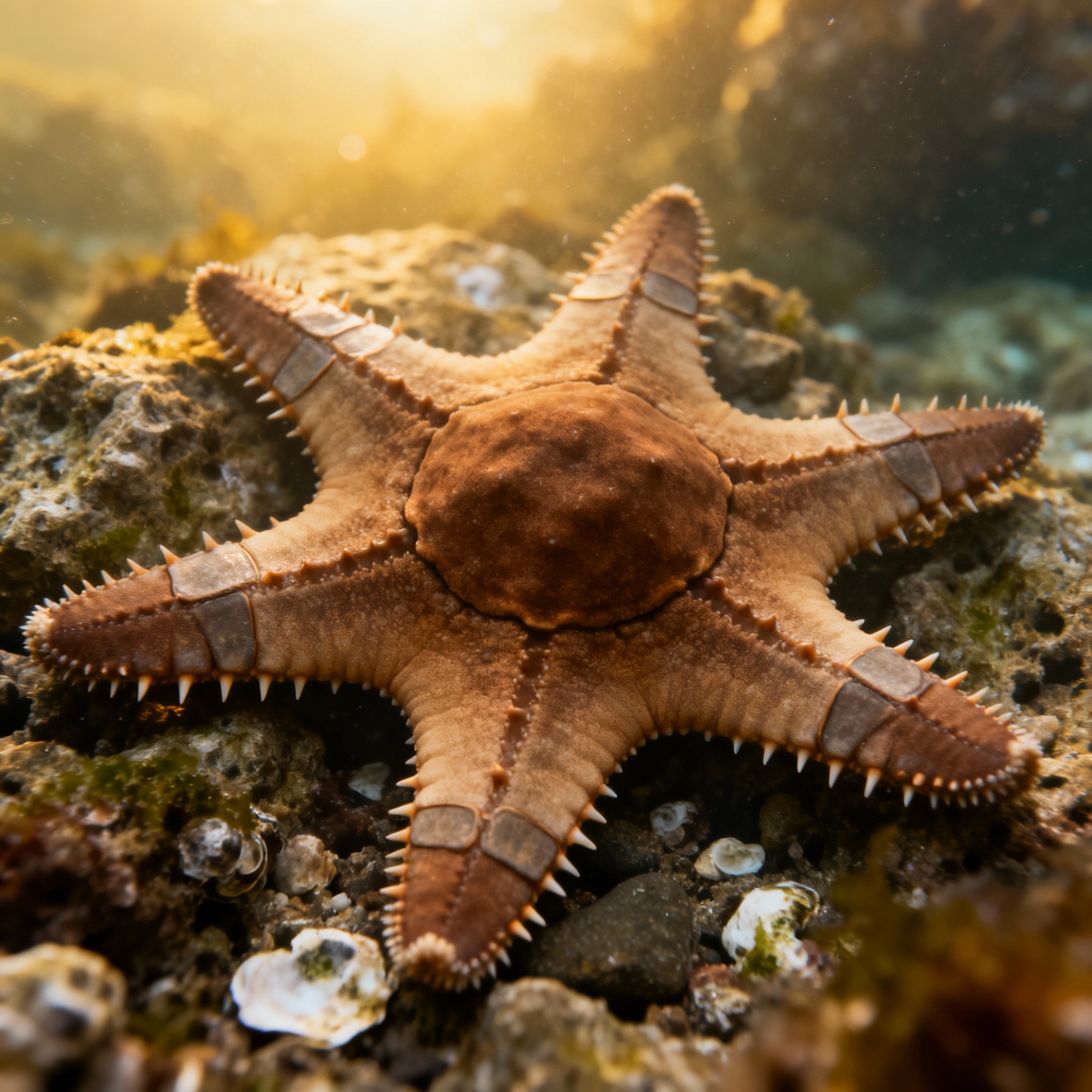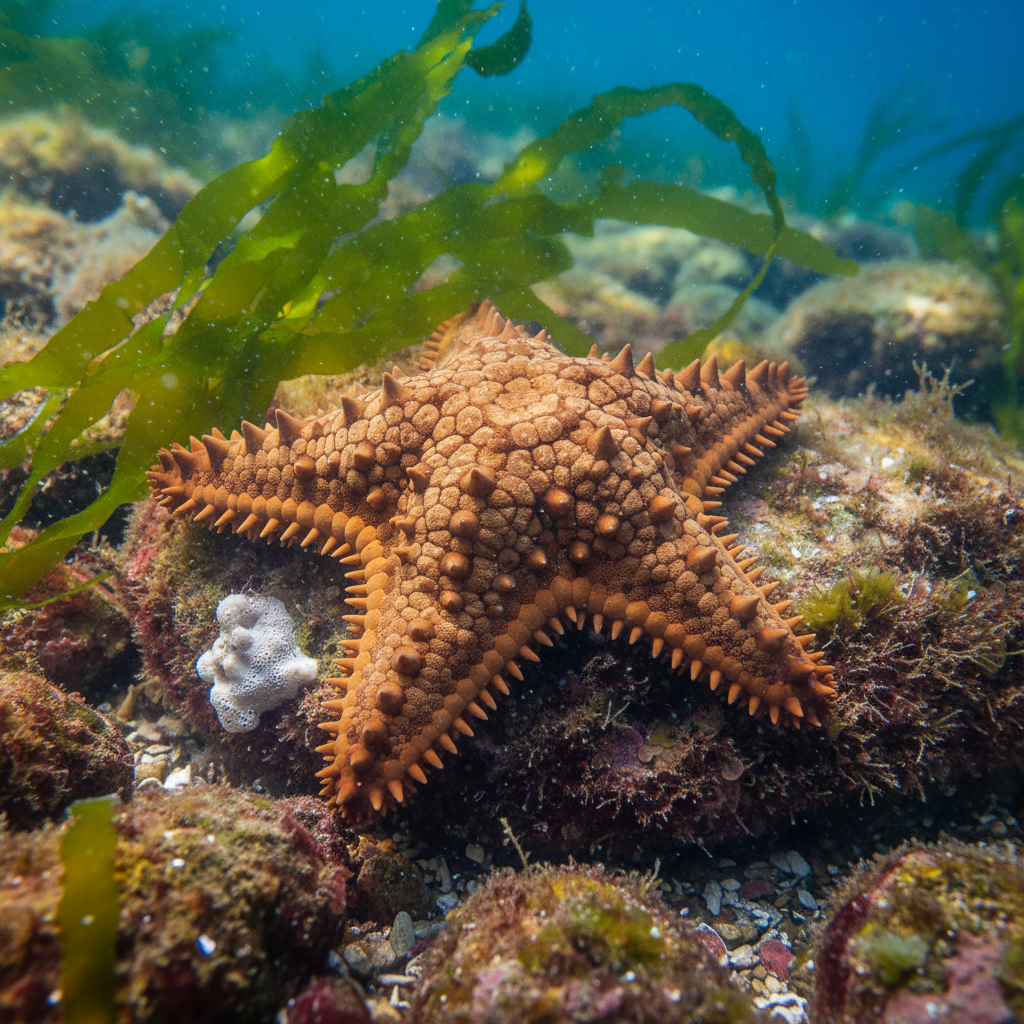Pentaceros: The Sea Pentagon (Starfish) – Morphology, Classification, Habitat, and Ecological Significance
Pentaceros, commonly described as the “sea pentagon” or starfish, is a classic genus representing pentaradial symmetry—one of the defining features of echinoderms. It is considered a key example in zoology for understanding echinoderm structure, regeneration, and evolutionary links among marine invertebrates. Starfish like Pentaceros are known for their five robust arms extending symmetrically from a central disc, forming a star or pentagonal shape, and exhibit remarkable regenerative abilities and ecological roles in marine environments
Classification of Pentaceros
| Taxonomic Rank | Name | Notable Features |
|---|---|---|
| Kingdom | Animalia | Multicellular, eukaryotic organisms |
| Phylum | Echinodermata | Spiny-skinned marine animals |
| Class | Asteroidea | Star-shaped body, tube feet for locomotion |
| Genus | Pentaceros | Five-armed starfish/sea pentagon |

Habit and Habitat
Pentaceros is found from shallow water to depths over 1,800 meters (1,000 fathoms). Its distribution includes the coasts of the United Kingdom, United States, India, Panama, and South America. Pentaceros inhabit rocky and sandy sea floors and are most common in benthic (bottom-dwelling) marine habitats, hiding under rocks or resting openly on the seabed.
General Characteristics
- Commonly called as sea pentagon or starfish.
- Body is enclosed in a tough, hard and leathery integument containing several ossicles.
- Central disc and the arms are fused together. Arms contain extension of gonad, coelom and the gut.
- Arms are 5 in number and symmetrically arranged in the form of star around the central disc.
- Body is differentiated into oral and aboral surfaces.
- Aboral surface is brown and convex, containing rows of definitely arranged spines.
- The marginal plates are large and distinct. There is a rounded sieve plate or madreporite plate in one of the inter-radii.
- It forms the first part of the water vascular system which is well developed.
- Oral surface is concave, dark brown, having a centrally-placed mouth or actinostome.
- Mouth is 5-angled and each angle is continued into the ambulacral groove up to the tip of an arm.
- Ambulacral groove contain double rows of locomotory organs of tube foot.
- Sexes are separate. Development indirect which includes bipinnaria larva.
- Pentaceros is the most familiar seashore animals.
- Body Symmetry: Exhibits classic pentaradial symmetry—with five symmetrical arms radiating from a round central disc forming a pentagon/star-like outline.
- Skin and Ossicles: Covered with a tough, leathery integument containing embedded calcified ossicles (small skeletal plates) and rows of protective spines.
- Oral/Aboral Surfaces: Distinct oral (lower) surface with mouth, and convex aboral (upper) surface, often brown with definitely arranged spines and large marginal plates.
- Madreporite Plate: A rounded sieve plate is present in one inter-radius, forming the first part of the water vascular system, crucial for movement and feeding.
- Tube Feet: Ambulacral grooves on the oral surface contain double rows of suction-bearing tube feet, essential for locomotion and prey capture.
- Regeneration: Capable of regenerating lost arms and even parts of the central disc, contributing to their resilience in the environment

Special Features
- Feeding: Pentaceros is a carnivorous opportunist, feeding mostly on mollusks (e.g., clams and snails), small crustaceans, and organic detritus. They can evert their stomach through the mouth to digest larger prey externally.
- Reproductive Biology: Sexes are separate (gonochoric), with external fertilization. They lay eggs which develop into free-swimming, bilaterally symmetrical larvae before metamorphosing into pentaradial adults.
- Evolutionary Significance: Starfishes like Pentaceros are vital for understanding deuterostome evolution and the transition from bilateral to radial symmetry in the animal kingdom.
- Ecological Impact: As key benthic predators, they regulate populations of mollusks and other invertebrates, maintain ecological balance, and promote biodiversity in marine communities
Identification
- Shape: Pentagonal to star-shaped with five robust arms.
- Surface: Brown and convex aboral surface (upper), robust marginal plates and spines, tube feet in oral ambulacral grooves.
- Size: Medium to large specimens, size varies by region and environmental conditions.
- Habitat: Found from intertidal to deep-sea zones, mostly on rocky and sandy substrate.
Life Cycle and Regeneration
- Larval Development: Eggs hatch into bilateral larvae, which later settle and metamorphose into pentaradial, arm-bearing adults.
- Regeneration: Can regrow lost arms and sometimes an entire individual from a single arm section—an extraordinary adaptation for survival and dispersal.

Ecological Role and Importance
- Predators: Control populations of mollusks and other benthic invertebrates.
- Regeneration Research: Model organisms for studying regeneration and developmental biology.
- Indicator Species: Reflect health and biodiversity of marine benthic systems.
- Geological Impact: Their ossicles contribute significantly to marine limestone sediments, providing clues for paleoecology and marine evolution.
References
- https://en.wikipedia.org/wiki/Pentaceros
- https://www.slideshare.net/slideshow/pentaceros-starfish-biodiversity-animal-science-zoology-biology/70568604
- https://www.svc.ac.in/SVC_MAIN/Departments/Zoology/Museum/MuseumData/1.%20NON%20CHORDATA/11_ECHINODERMATA/1.11%20ECHINODERMATA.pdf
- https://byjus.com/neet/diagram-of-starfish/
- https://en.wikipedia.org/wiki/Echinoderm
- https://patnawomenscollege.in/upload/e-content/General-Characteristics-and-Classification-of-Echinodermata.pdf
- https://byjus.com/biology/echinodermata/
- https://www.marinespecies.org/aphia.php?p=taxdetails&id=213285
- https://www.youtube.com/watch?v=nqNnRt0TlQs

